|
Maxton

Above map of the Diamond brewery ground, 22 October 1922. |
 |
|
Maxton in the 1890's, with the old manor house on the
left and the Diamond Brewery in the centre. E. Dawes and Sons' brewery
sign on the left spans the yard which still exists between the Diamond
Stores, in Folkestone Road, and the premises occupied until recent years
by Mr Hector Langford, the newsagent. The gently sloping roof of the
building on the right is that of a barn which has long been used as a
garage but once housed the brewery drays. Two of the drays are visible
on the right of the picture which was taken by Whorwell, of Bench
Street, and published in the Dover Standard's illustrated visitors' list
in the 1890s.
In the 1890s, the manor house, which stood just beyond the old
tram terminus, now a council garage adjoining the Orange Tree public
house, became the home of a Mr Dawes, who ran the Diamond Brewery for a
time and also had the Diamond Stores next door. An old barn believed to
have been used to house the brewery drays, still stands, set back from
the road at the side of the Diamond Brewery Stores and off-licence.
Another building at the rear, used until recent years by Whitbreads, was
the old granary of the brewery. The Diamond Brewery had a succession of
owners, including "T. Phillips and Co.", who took over from Mr Dawes, and
Allen and Co. The site of the manor house, which was demolished in the
first half of the 20th century, is now occupied by a petrol filling
station. |

Advert that appeared in the Folkestone Express, early 1881. |
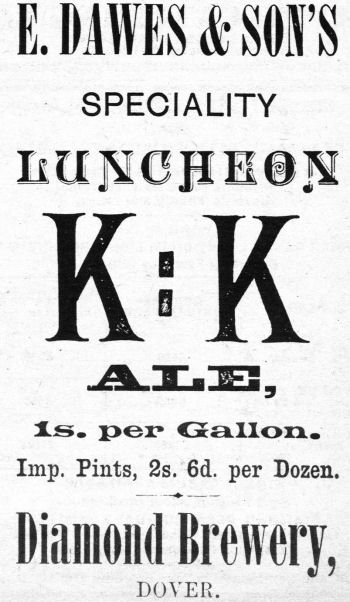
In their 1890s advertisement, reproduced below, Dawes and Sons offered
their speciality - a luncheon ale costing one shilling a gallon!
Information taken from John Bavington Jones' book "A Perambulation of
the Town, Port and Fortress of Dover", 1906. (Reprint in The Dover
Express, 7th November, 1980.) |
|
From Coopers and Custom Cutters by Janet Probyn
Worthington.
The Diamond Brewery
The Diamond brewery was the building closest to Maxton Manor on the
Folkestone Road and it is believed to have been built by Henry
Worthington after he
bought the property from John Minet Fector, Esq. in 1849.
At various times of his life, such as the christening of his seventh
child Maria Henrietta Adelaide on 2 December 1840, Henry gave his
occupation as that of wine merchant or brewer. The yearly registers of
Dover Freemen regularly record Henry as a wine merchant at Snargate
Street in 1832/3, at Strond Street in 1834/5 and as an innkeeper in
1836. A notice in the Dover Telegraph on 6 September 1834 reports that
J. Poulter had taken over Henry Worthington's (wine, spirit and porter
merchant) business at 157 Snargate Street, Dover. Mr. Poulter was
perhaps only managing the
business because the following information was placed in the Dover
Telegraph on 29 April 1843 by Henry: 'extensive offices and warehouses,
no.157 Snargate Street, where places can be secured for the several
trains and parcels, goods and luggage booked and forwarded to any part
of the kingdom with the utmost regularity and dispatch'.
Caves situated in the limestone cliffs of Finnis Hill, Dover, a very
good storage place for wine because of the even temperature and
humidity, were listed beside Henry's name in the rating book for St
Mary's Parish, Dover ('Pier Ward') 1838-9. Valued at £7 10s. with an
assessment of 2s. 6d., these caves are still used for storage. Another
entry attributed to Henry in the same rating book was for a lodge with a
valuation of £15, and an annual assessment of 5s.
The name Worthington appears as owner of 'wine vaults near Snargate
Street' on 19 February 1841 when George Gray was the occupier. A
Worthington may have owned these vaults prior to this date. However the
church record books for the 1830's do not name the owner of a property,
only the occupier. George Gray occupied the property here as far back as
1818 but it is described as a house on Western Heights. It is not
described as wine vaults until 3 November 1840. Perhaps this was the
date when the Worthington's purchased them. George Gray ceases to occupy
them by 10 November 1843 and 'Worthington' occupied the wine vaults from
16 February 1844 to 16 August 1844. B. and H. Worthington occupied the
vaults from 16 February 1846 until 20 November 1846 and David Barnard
occupied them from 16 July 1847 to 27 April 1850 although B. and H.
Worthington still owned them.
An article in the Dover Express and East Kent News on Friday, 26
December 1941 queried the 'much discussed origin' of the Snargate Street
caves. The journalist refers to a book called Ireland's History of Kent
(published 1829) which said: We are informed by Mr Batchellor that Mr Hight, in constructing the wine
vaults for Mr Worthington, in Snargate Street, when excavating the
ground for a poaded vault, at about ten feet from their entrance discovered in the fissures of the
rock the beach that had been washed in by the force of the waves; and,
at a few feet farther from the entrance, masses of beach were clearly
discernible; affording convincing proof that the sea formerly washed
against the base of the cliffs in question. The article went on to say that although the date Mr. Hight built the
vaults had not been found, a Mr. Hight, builder, lived at 7 St James'
Terrace, Dover in 1837. The caves belonged at some stage to the once
well-known firm of wine merchants Messrs. Court & Co, who were in
business in Snargate Street prior to 1837 and it is possible that the
vaults constructed for the Worthingtons may have been an addition to the
network of caves already in use by Mr. Court. A plan of this firm's use
of the caves was printed in an Official Illustrated Guide to the
South-Eastern Railway, issued in 1863.
In Kelly's 1855 Directory, Henry Worthington is described as a farmer
and brewer of Folkestone Road in the Parish of Hougham. Henry alone is
listed as owner of the Snargate Steet wine vaults from 17 October 1855
until 8 January 1863, with D. Barnard the occupier. The Crown appears as
owner in October 1863 and Barnard and Co. own and occupy them from
January 1864.
Two of Henry's sons were known to be brewers. The last record of a
brewer in the family relates to his youngest son Robert. The 1870 Kent
Post Office Directory includes under brewers: Robert Worthington,
Maxton, Hougham, Dover.
The brewery premises, along with all his estate in Maxton, were left in
Henry's will dated 16 December 1865, to his brothers-in-law, the Rev.
Peter Harnett Jennings of Longfield Rectory, Gravesend and Robert Finnis
Jennings of River, Esquire. These properties were left in trust, to pay
yearly rent equally to his daughters Sophia and Maria Henrietta while
they remained single. Upon their marriage or deaths the properties were
to be sold at auction. After Sophia's death in Rome in 1883 and
Maria's 1885 marriage in Rome the estate was auctioned on 30 July 1885
in accordance with the terms of the will. John James AlIen was the
successful bidder for '...All the Manor or Lordship of Maxton in the
Parish of Hougham otherwise Huffam... And also all the messuage of
dwellinghouse called Maxton with the Brewery brick chimney shafts and
other erections and buildings.' AlIen payed £1,500 for the house and
grounds and £350 for the brewery. His purchase also included: 'all that messuage or tenement beer house and premises known by the name or sign
of the "Hare and Hounds" and the appurtenances thereto belonging
situated at Maxton'. It appears from the property's sale indenture that
Robert Worthington was the lessee of the brewery and beer house which
were situated within a mile of each other.
The brewery was sold again in 1889 to Stanley Single; in 1891 to Edwin
Dawes and in 1898 to Thos. Phillips and Co. Ltd., brewers of West
MaIling, Kent and Dover against whom a winding up order was made in
December 1907. On 14 April 1908 the first meeting of creditors was
heard in London and the deficiency of funds was estimated at £55,000.
The company and its assets were sold off and Alfred Leney & Co. of
Phoenix Brewery, Castle Street, Dover, purchased the Diamond Brewery and
other properties. It was then run as an Off Licence with parts sold
gradually over the years."
|
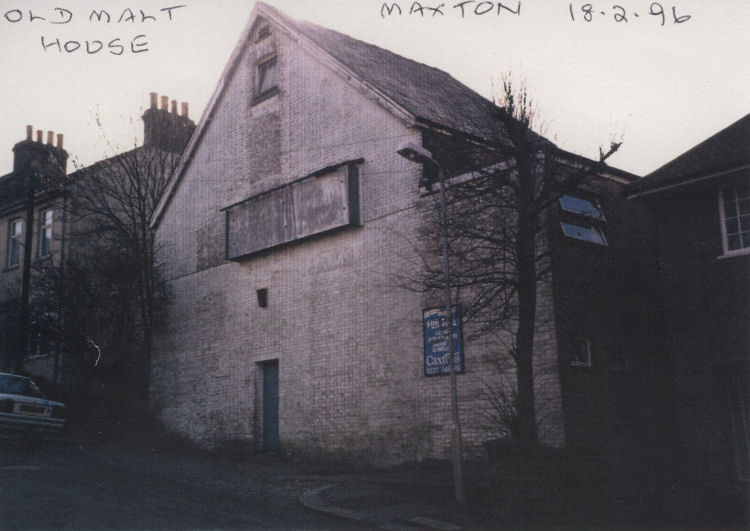 |
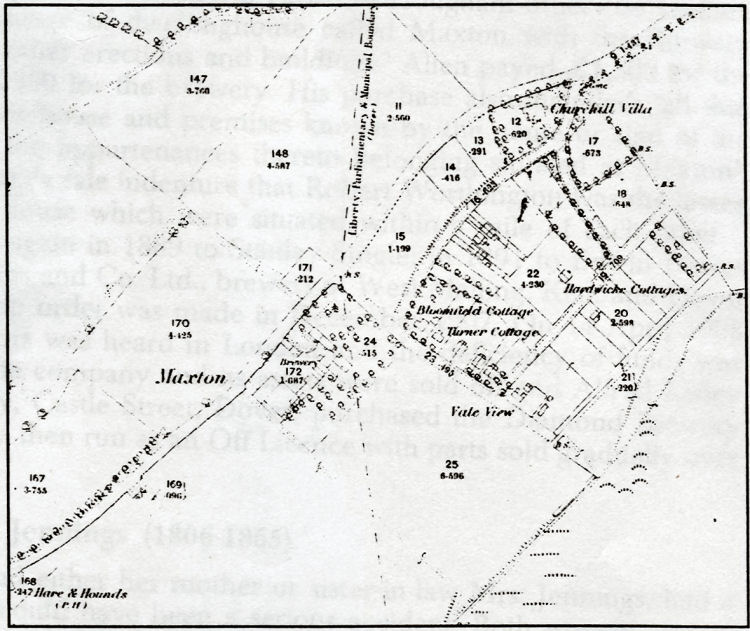 |
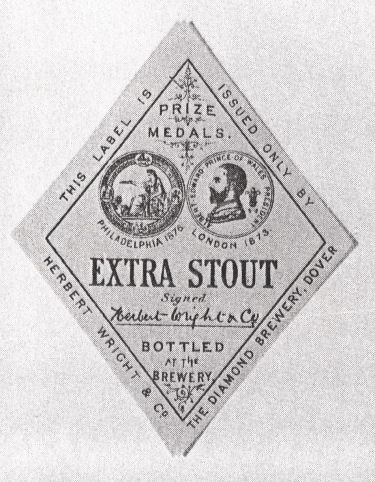 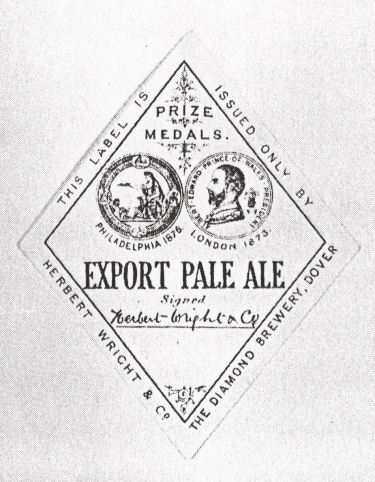
Above shows two bottle labels from the Diamond Brewery.
|
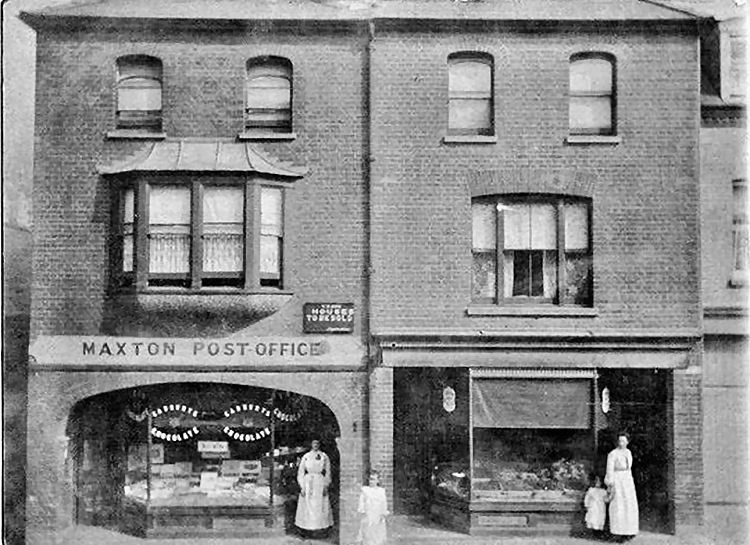
Maxton Post Office circa 1900. Kindly sent by Paul Wells. This later
became the Diamond Stores. |

Photo kindly supplied by Jan Pedersen showing the buildings just at the
back of the "Diamond Stores."
|

Above picture taken from Google June 2009 showing the same area taken
from the opposite direction. The building shown above would have been
where the cars parked under the PROTON sign are now.
|
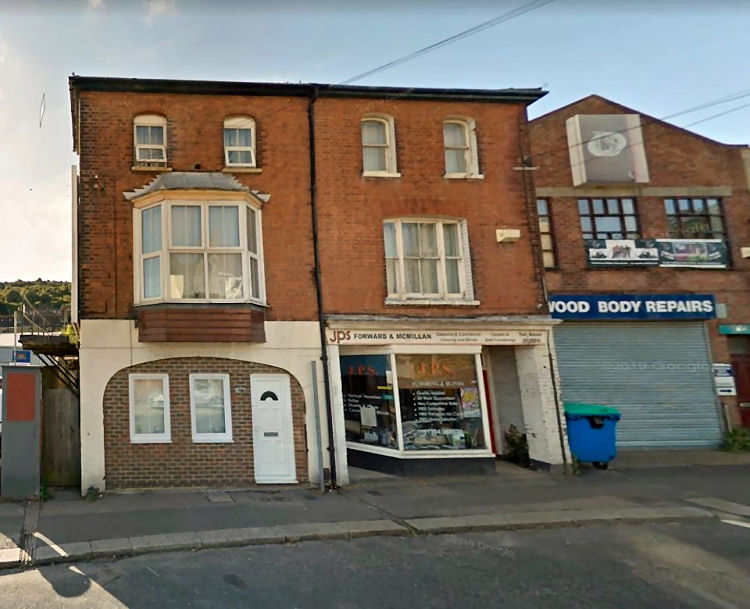
Above photo, 2019. |
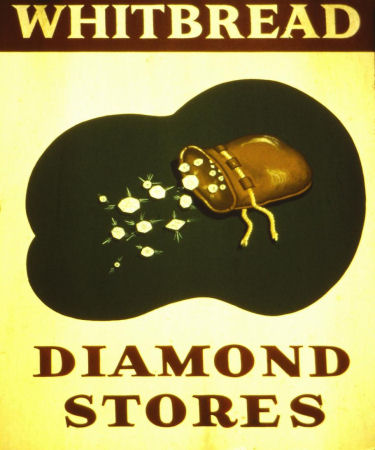
Above sign which hung outside the off-license, 1980.
With thanks from Brian Curtis
www.innsignsociety.com.
|
|
From the Dover Express and East Kent News, Friday, 12 October, 1877. Price 1d.
THE HYDROPHOBIA PANIC IN DOVER
A great deal of excitement has been caused in the town by the death, on
Sunday last, of a labourer named James Whaley, at Maxton, from
hydrophobia. It is to be regretted that, in a case of so much importance
to the public at large, a coroner's inquest was not held in order that
the whole of the facts might be placed on record. As far as we can
gather the particulars it appears that four weeks ago last Monday
morning Whaley, who is employed at Maxton brewery, went at three o'clock
in the morning into the brewery yard to call up a man who lives there.
On passing in at the gate he saw there a large strange dog. Whaley made
a pretence of throwing at the dog in order to frighten it him away, but
the dog instead of bolting made a dash at the man and bit him on the
forehead, over the eye. The dog then disappeared. We understand that in
the course of the day Whaley came into the town to a chemist to have the
wound dressed, but that the chemist (we have not heard who he was) did
not regard the bite as being serious. A neighbour at Maxton, however,
was not so comforting to the poor fellow, for on his showing her the
bite, she remarked “Well, Jim, poor as I am, I would not have that bite
which you have for a thousand pounds.” Time passed on, the wound healed,
and Whaley thought but little more of it until Friday morning last when
he was taken ill. On Saturday he grew worse and on Sunday he went raving
mad. Mr. Clement Walter and Mr. Grandison attended him, but their
services were altogether unavailing, the case being regarded as hopeless
from the first. In the earliest part of Sunday the poor fellow, thought
very excited, was sensible, but towards the evening he tried to leap out
of the window, and eventually it was the work of six men to hold him.
The neighbours say that towards the last his cries were like the bark of
a dog. He died on Sunday evening in terrible agony.
Turning from the sad scene to the animal that was the cause of the
calamity, at appears that on the day that Whaley was bitten a rabid dog
was seen running about Buckland and he was snapping at all dogs that
came in his way. Mr. R. H. Jones, going to the Police Court the same
morning, gave information of the facts to the Police, and Sergeant
Johnston and Constable Ash went in search of the dog and at 11.30 a.m.
they found him lying exhausted in a garden at the back of Mr. Ashdown's
paper mill. The Officers procured a double-barrelled gun, with which
they shit the dog, and buried him on the spot. The animal is described
as being of the lurcher breed, of considerable size, standing about a
yard high. In his career up Buckland, he is suppose to have bitten
several dogs, more particularly one belonging to Mr. Jones, of Mr.
Mannering's Mill, which dog has been shot, and another, belonging it is
said to Miss Loud, and that one has been kept chained up since, but we
believe shows no signs of madness. The Police have since heard of some
other dogs which were bitten, and the owners of them have been
cautioned.
The consternation caused by this case of hydrophobia has brought out
statements that there are several persons in the borough who have been
bitten. One man and two children are specified, but the bites have been
cauterized, and it is hoped that no bad results will follow. We learn,
too, that a lady visitor (a well-known authoress) staying here has been
bitten.
It is not surprising that with such a state of things existing an
application should have been made to the Mayor by the Superintendent of
Police for the prohibition of dogs, not under control, from being in the
streets. We have several times urged, during the past summer, that such
a course should be adopted, and the precaution taken late is better late
than never. The order is to the effect that dogs in the street must
either be muzzled or be led by some one in charge. It will be the
disagreeable duty of the Police to take into custody all dogs found at
large. If the owners apply for them, we suppose they will be liable to a
penalty for allowing them to be at large; if they do not supply for them
the dogs will be destroyed.
Dr. G. O. Drewry, editor of “Health,” in an article in this month's
number, makes the following statements (1.) that Hydrophobia is on the
increase. (2.) That the poison causing Hydrophobia is always
communicated by the saliva of the dog passing by a bite into the blood
or an open wound. (3.) That no person actually attacked with Hydrophobia
ever recovered. (4.) That many persons are bitten by mad dogs without
having the disease. (5.) That the disease very seldom appears later than
three months after the bite. (6.) that the best remedy is burning with a
hot iron, or sucking the bite, which is not dangerous. (7.) That
Hydrophobia might be stamped out by preventing dogs from running at
large.
|
|
Whitstable Times and Herne Bay Herald, 7 April 1870.
FIRE AT MAXTON BREWERY.
A fire of a rather serious nature occurred on Monday afternoon, at Mr.
Worthington's Brewery, on the Maxton Estate, Folkestone Road. It is
supposed to have originated from a spark from the chimney of the steam
engine blowing on to the thatched roof of the store-house adjoining, for
when first discovered the flames were rising from this building. All
hands on the brewery, together with a few persons gathered near,
immediately went to work, and threw buckets of water upon the fire; but
the flames by this time had obtained complete mastery of the building,
and all hopes to save the property were given up. The main object now
was to keep the brew-house and adjoining buildings that the fire had not
touched cool, and prevent it if possible from spreading. Several
gentlemen from Dover who were upon the spot, rendered great help in
superintending these proceedings. The only water that was available was
from a well adjoining. The scanty supply of water that has been resorted
to in the first instance was soon exhausted, and beer and porter barrels
were tapped and their contents thrown in buckets full over the burning
mass. Shortly after, the engine arrived from Dover and the fire was
extinguished. The actual cause of the fire is at present unknown, and
the damage is estimated at from £300 to £400. Mr. Worthington is,
however, insured in the "Alliance" Office.
|
|
From the Dover Express and East Kent News, Friday, 12 July, 1889. Price 1d.
TRANSFERS
Mr. Spain applied for the transfer of Maxton Brewery from Mr. J.
Allen to the present proprietor. (Stanley
Single)
|
|
From the Dover Express and East Kent News, Friday, 17 July, 1891. Price 1d.
BUTLER v. SINGLE
This was a claim of £14 5s. 10d. loss of commission by reason of
dismissal from the defendant's service.
Mr. M. Mowll appeared for the plaintiff, and Mr. A. Harby for the
defendant.
From the statements of the solicitors, and the evidence of the
plaintiff, at appeared that the plaintiff was traveller to Mr. Single,
at the “Diamond Brewery,” Maxton. He had been in the situation for some
years. At the end of January an agreement was entered into by the
defendant and plaintiff, according to which he was to have 20s. a week
and 5 per cent. commission on all money collected for orders he
received. At the end of February he was dismissed, he having first given
notice, and two week's salary, £2, was paid in lieu of notice. He was
also paid 7s. 8d. commission. The claim was for £8 15s. 10d. percentage
on money he had collected during February on orders he had received
before the agreement was entered into, which he claimed under a clause
in the agreement, and £6 commission lost by his dismissal.
His Honor having heard the various arguments and the plaintiff's
evidence, said that the plaintiff could not claim a commission on money
he received for orders obtained before the agreement had existed. On the
second claim he awarded the plaintiff 30s.
This concluded all the business of public interest.
|
|
From the Dover Express and East Kent News, Friday, 3 July, 1914. Price 1d.
DIAMOND BREWERY NEW TENANT
At the Dover Police Court this (Friday) morning, before Mr. M. Pepper
(in the chair), Messrs. G. C. Rubie, Edward Chitty, and H. Hobday.
An application was made by Mr. G. Wood, for a temporary transfer of the
licence of Maxton Brewery, from Mr. A. C. Wilson to Messrs. Lukey and
Co., wine merchants.
The Chairman: How long have you held the licence?
Mr. Wood: Since we acquired the property, and we temporarily held the
licence until we got a tenant.
The chairman: Then it does not come under the nine months clause.
The Magistrates' Clerk: No.
Mr. Chitty: is trade being carried on at the present time?
Mr. Wilson: Oh, yes.
|
|
From the Dover Express and East Kent News, Friday, 2
October, 1914. Price 1d.
TRANSFER
Allsopp's Stores, Strond Street were transferred from Mr. Terson to
Mr. Sandford, for Messrs. G. Beer and Co., who are using them as stores.
The Maxton Brewery Stores from Mr. Watson to Mr. J. E. Lukey.
|
|
Found by Jan Pedersen at a boot fair 10 June 2011.


Photographs kindly supplied by Jan Pedersen. |
Bought by Alfred Leney Co Ltd, after closure in 1907, until bought out by Fremlin
Brothers brewery of Maidstone in 1926, brewing at the Dover brewery ceased
in 1927, which later passed to Whitbread.
FECTOR John Minet 1849
WORTHINGTON Henry 1849-65
WORTHINGTON Robert 1865-85
ALLEN John James 1885-July/89

SINGLE Stanley July/1889-91

DAWES E & Sons 1891-98 (Also brewers and wine & spirit merchants 1899 ) )
PHILLIPS & Co Ltd 1899-1908

LENEY Alfred & Co 1908
LUKEY Mr June/1919

WOOD Mr G P June/1919+

 From the Kelly's Directory 1899 From the Kelly's Directory 1899
 From the Post Office Directory 1901 From the Post Office Directory 1901
 From the Dover Express From the Dover Express
|












